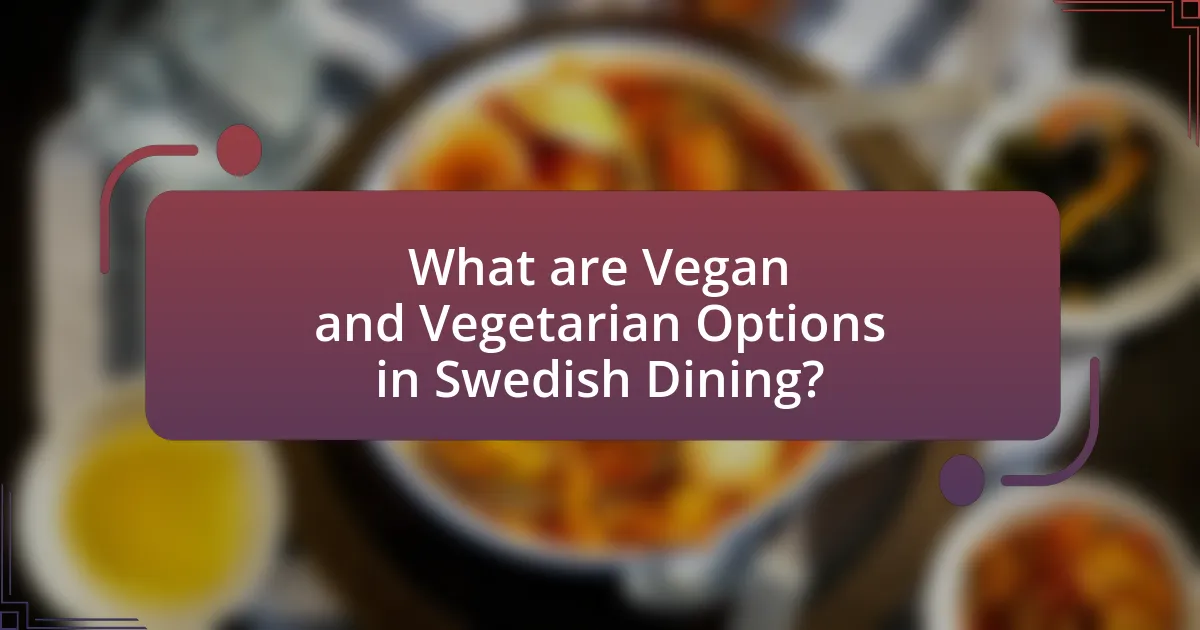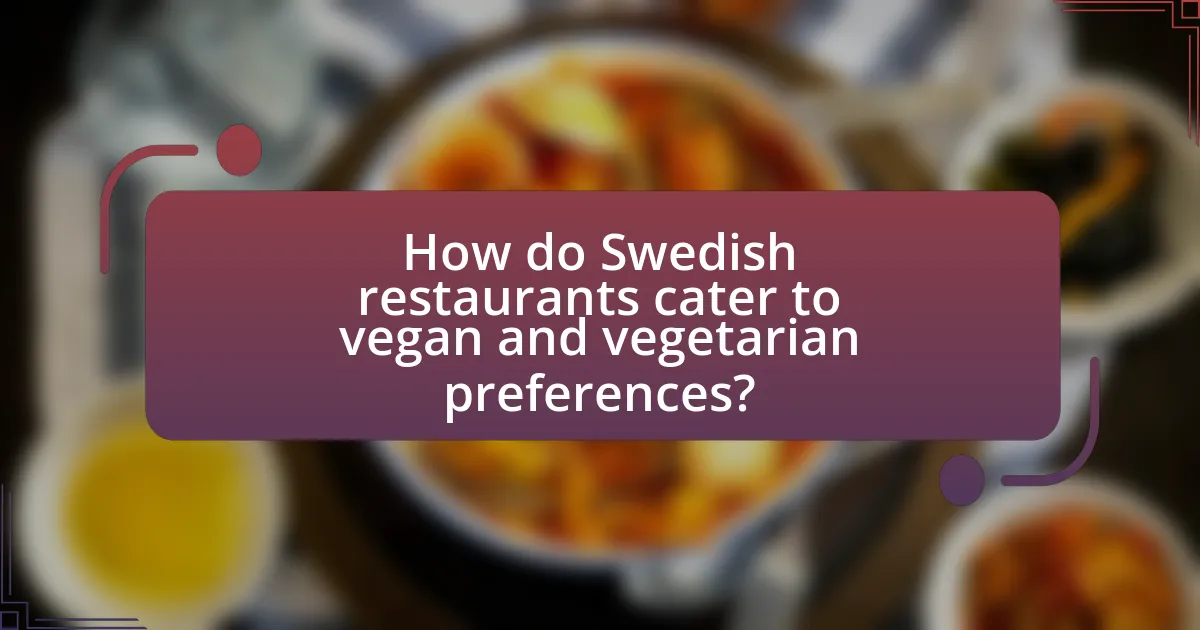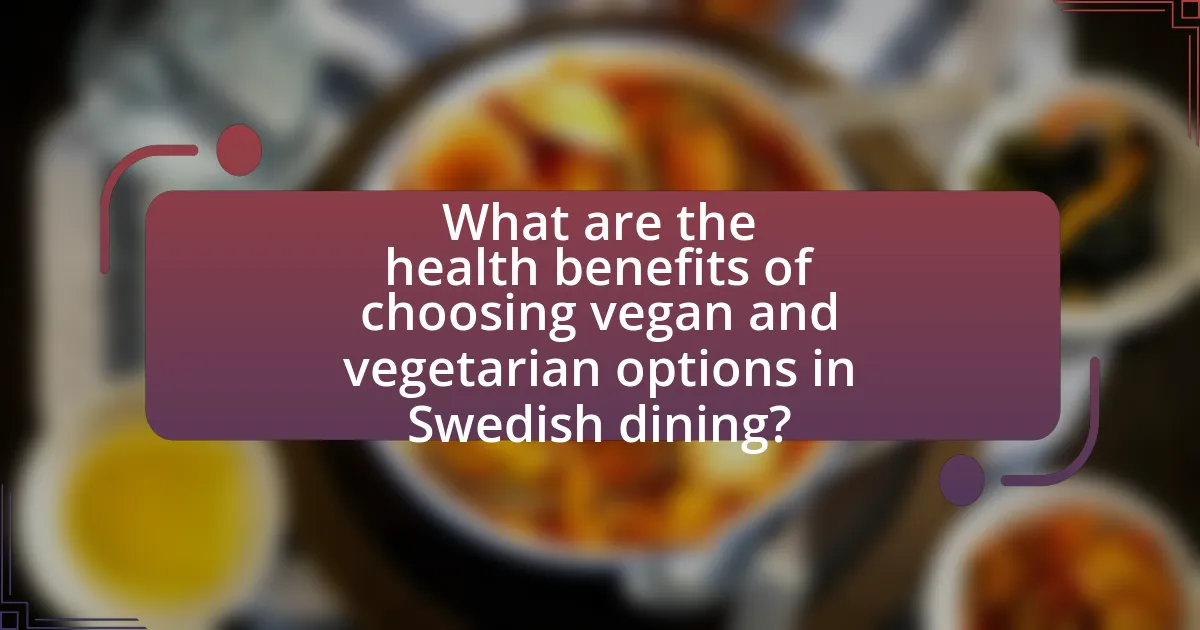The article focuses on vegan and vegetarian options in Swedish dining, highlighting the diverse plant-based dishes available in restaurants across the country. It examines the evolution of these diets in Sweden, influenced by historical factors, cultural attitudes, and government initiatives promoting plant-based eating. The article also discusses the types of plant-based menus offered, adaptations of traditional Swedish dishes, and the incorporation of international cuisines. Additionally, it addresses challenges faced by diners, the health benefits of plant-based diets, and resources for finding vegan and vegetarian dining options in Sweden.

What are Vegan and Vegetarian Options in Swedish Dining?
Vegan and vegetarian options in Swedish dining include a variety of plant-based dishes such as vegetable gravlax, mushroom burgers, and lentil stews. Many Swedish restaurants now offer dedicated vegan and vegetarian menus, reflecting the growing demand for plant-based cuisine. For instance, traditional dishes like “kåldolmar” (cabbage rolls) can be made with rice and vegetables instead of meat, and “ärtsoppa” (pea soup) is often available in a vegetarian version. The Swedish government has also promoted plant-based diets through initiatives aimed at reducing meat consumption, further encouraging restaurants to diversify their menus with vegan and vegetarian choices.
How have vegan and vegetarian diets evolved in Sweden?
Vegan and vegetarian diets in Sweden have evolved significantly over the past few decades, transitioning from niche options to mainstream dietary choices. In the 1990s, vegetarianism was primarily associated with health and ethical concerns, but by the 2010s, the rise of veganism gained momentum due to increased awareness of environmental issues and animal welfare. According to a 2021 report by the Swedish Food Agency, approximately 10% of the Swedish population identifies as vegetarian, while around 3% follow a vegan diet, reflecting a growing acceptance and demand for plant-based foods. This shift has led to an expansion of vegan and vegetarian offerings in restaurants and supermarkets, with many traditional Swedish dishes being adapted to meet plant-based preferences.
What historical factors influenced the rise of plant-based diets in Sweden?
The rise of plant-based diets in Sweden has been influenced by several historical factors, including agricultural practices, economic shifts, and cultural movements. The transition from traditional farming methods to more sustainable practices in the late 20th century encouraged a focus on plant-based foods. Additionally, the environmental movement in the 1960s and 1970s raised awareness about the ecological impact of meat consumption, leading to increased interest in vegetarianism and veganism. Furthermore, Sweden’s strong welfare state and emphasis on health and sustainability have supported the growth of plant-based diets, as seen in government initiatives promoting healthy eating. These factors collectively contributed to the acceptance and popularity of plant-based diets in Swedish society.
How do cultural attitudes towards veganism and vegetarianism shape dining options?
Cultural attitudes towards veganism and vegetarianism significantly influence dining options by determining the availability and variety of plant-based meals in restaurants and cafes. In Sweden, for instance, a growing acceptance of vegan and vegetarian diets has led to an increase in establishments offering diverse plant-based menus, reflecting societal values that prioritize sustainability and health. According to a 2021 report by the Swedish Board of Agriculture, nearly 30% of the population identifies as flexitarian, which has prompted many dining venues to adapt their offerings to cater to this demographic, ensuring that vegan and vegetarian options are not only available but also appealing and innovative. This shift in cultural perception has resulted in a broader acceptance of plant-based diets, directly shaping the culinary landscape and dining experiences across the country.
What types of plant-based menus are available in Swedish restaurants?
Swedish restaurants offer a variety of plant-based menus, including fully vegan options, vegetarian dishes, and flexitarian choices. Vegan menus typically feature items such as plant-based burgers, salads, and pasta dishes made without animal products. Vegetarian menus often include dairy and egg-based options, such as cheese platters and omelets. Flexitarian menus provide a mix of plant-based and meat dishes, catering to those who occasionally consume animal products. The increasing demand for plant-based dining in Sweden is supported by a 2021 report from the Swedish Board of Agriculture, which noted a significant rise in plant-based food consumption among the population.
Which traditional Swedish dishes have been adapted for vegan and vegetarian diets?
Traditional Swedish dishes that have been adapted for vegan and vegetarian diets include köttbullar (meatballs), which are now made with plant-based proteins, and gravlax, which has been replaced with marinated carrots or beets to mimic the texture and flavor. Additionally, traditional creamy sauces are often made with cashew or almond cream instead of dairy, and classic dishes like Janssons frestelse (a potato casserole) can be prepared using plant-based cream and vegan anchovies. These adaptations maintain the essence of Swedish cuisine while catering to dietary preferences.
How do modern Swedish restaurants incorporate international plant-based cuisines?
Modern Swedish restaurants incorporate international plant-based cuisines by integrating diverse culinary techniques and ingredients from around the world into their menus. For instance, many establishments feature dishes inspired by Mediterranean, Asian, and Middle Eastern cuisines, utilizing ingredients like chickpeas, lentils, and various spices to create flavorful plant-based options. This trend is supported by the increasing demand for vegan and vegetarian choices, with a 2021 report indicating that 30% of Swedish consumers actively seek plant-based meals. Additionally, chefs often experiment with traditional Swedish ingredients, such as root vegetables and grains, while applying international cooking methods, resulting in innovative dishes that reflect a global influence.
What are the challenges faced by vegan and vegetarian diners in Sweden?
Vegan and vegetarian diners in Sweden face several challenges, including limited menu options, lack of awareness among restaurant staff, and cultural perceptions of plant-based diets. Many restaurants do not offer sufficient vegan or vegetarian dishes, making it difficult for diners to find suitable meals. Additionally, staff may not be well-informed about vegan and vegetarian ingredients, leading to potential cross-contamination or unintentional inclusion of animal products. Cultural attitudes towards meat consumption can also create barriers, as traditional Swedish cuisine heavily features meat, which may result in a lack of acceptance for plant-based diets in some dining establishments.
How accessible are vegan and vegetarian options in rural versus urban areas?
Vegan and vegetarian options are generally more accessible in urban areas compared to rural areas. Urban regions often have a higher concentration of restaurants, grocery stores, and markets that cater to plant-based diets, with many establishments specifically offering vegan and vegetarian menus. In contrast, rural areas typically have fewer dining options and grocery stores, which may limit the availability of diverse plant-based products. A study by the Swedish Board of Agriculture indicates that urban areas have a greater variety of food outlets, with 70% of urban residents reporting easy access to vegan options, while only 30% of rural residents have similar access. This disparity highlights the challenges faced by individuals in rural areas seeking vegan and vegetarian choices.
What misconceptions exist about vegan and vegetarian dining in Sweden?
A common misconception about vegan and vegetarian dining in Sweden is that it lacks variety and flavor. In reality, Sweden offers a diverse range of plant-based options, influenced by both traditional Swedish cuisine and international culinary trends. For instance, many restaurants in urban areas like Stockholm and Gothenburg feature innovative vegan dishes that incorporate local ingredients, such as root vegetables and berries, alongside global flavors. Additionally, a report from the Swedish Food Agency indicates a significant increase in the availability of plant-based products in supermarkets, reflecting a growing demand for diverse vegan and vegetarian options.

How do Swedish restaurants cater to vegan and vegetarian preferences?
Swedish restaurants cater to vegan and vegetarian preferences by offering diverse plant-based menus that include innovative dishes made from local ingredients. Many establishments provide clearly labeled vegan and vegetarian options, ensuring transparency for diners. For instance, a survey by the Swedish Food Agency in 2021 indicated that 30% of restaurants in Sweden now feature dedicated vegan menus, reflecting a growing trend towards plant-based dining. Additionally, popular dishes often incorporate traditional Swedish flavors, such as vegan versions of meatballs made from lentils or chickpeas, showcasing the culinary adaptation to meet dietary needs.
What strategies do restaurants use to create appealing plant-based menus?
Restaurants create appealing plant-based menus by incorporating diverse ingredients, focusing on flavor profiles, and emphasizing presentation. By utilizing a variety of seasonal vegetables, grains, and legumes, restaurants can offer unique dishes that cater to different tastes and dietary preferences. Flavor profiles are enhanced through the use of herbs, spices, and innovative cooking techniques, which can elevate the dining experience. Additionally, visually appealing presentations attract customers, making plant-based options more enticing. Research indicates that visually appealing dishes can significantly influence consumer choices, highlighting the importance of aesthetics in menu design.
How do chefs source ingredients for vegan and vegetarian dishes?
Chefs source ingredients for vegan and vegetarian dishes primarily through local farms, specialty markets, and sustainable suppliers. By establishing relationships with local farmers, chefs ensure access to fresh, seasonal produce, which enhances the quality and flavor of their dishes. Additionally, many chefs prioritize organic and ethically sourced ingredients, often collaborating with suppliers who adhere to sustainable practices. This approach not only supports local economies but also aligns with the growing consumer demand for transparency in food sourcing. Studies indicate that sourcing locally can reduce carbon footprints and promote biodiversity, making it a preferred method among chefs focused on plant-based cuisine.
What role does seasonal produce play in menu development?
Seasonal produce plays a crucial role in menu development by enhancing flavor, freshness, and sustainability. Utilizing seasonal ingredients allows chefs to create dishes that reflect the natural growing cycles, ensuring optimal taste and nutritional value. For example, in Sweden, the availability of fresh vegetables like root crops in winter and berries in summer influences menu offerings, promoting local sourcing and reducing carbon footprints. This practice not only supports local farmers but also aligns with consumer preferences for fresh, high-quality ingredients, thereby improving customer satisfaction and loyalty.
How do customer preferences influence plant-based menu offerings?
Customer preferences significantly influence plant-based menu offerings by driving restaurants to adapt their selections to meet the demand for healthier and sustainable options. Research indicates that a growing number of consumers are prioritizing plant-based diets for health benefits, environmental concerns, and ethical reasons, leading to a 300% increase in plant-based food sales in the past decade. Consequently, restaurants are expanding their plant-based offerings to attract these health-conscious and environmentally aware customers, ensuring that their menus reflect current dietary trends and preferences.
What trends are emerging in vegan and vegetarian dining in Sweden?
Emerging trends in vegan and vegetarian dining in Sweden include an increase in plant-based menu options, innovative culinary techniques, and a focus on sustainability. Restaurants are expanding their offerings to include diverse international cuisines that highlight plant-based ingredients, reflecting a growing consumer demand for variety and flavor. Additionally, chefs are utilizing advanced cooking methods, such as fermentation and smoking, to enhance the taste and texture of plant-based dishes. The emphasis on sustainability is evident as many establishments prioritize locally sourced ingredients and environmentally friendly practices, aligning with Sweden’s broader commitment to ecological responsibility. These trends are supported by a significant rise in the number of vegan and vegetarian restaurants, which increased by over 30% in recent years, indicating a robust shift in dining preferences among the Swedish population.
How do customer reviews impact restaurant menu decisions?
Customer reviews significantly influence restaurant menu decisions by providing direct feedback on customer preferences and satisfaction levels. Restaurants analyze reviews to identify popular dishes and ingredients, allowing them to adjust their menus to better align with customer tastes. For instance, a study published in the Journal of Foodservice Business Research found that restaurants that actively respond to customer feedback and adapt their offerings see a 20% increase in customer retention. This data underscores the importance of customer reviews in shaping menu items, particularly in the context of vegan and vegetarian options, where consumer demand is rapidly evolving.

What are the health benefits of choosing vegan and vegetarian options in Swedish dining?
Choosing vegan and vegetarian options in Swedish dining offers numerous health benefits, including lower risks of chronic diseases, improved heart health, and better weight management. Research indicates that plant-based diets are associated with reduced incidences of heart disease, type 2 diabetes, and certain cancers due to their high content of fiber, vitamins, and antioxidants. For instance, a study published in the Journal of the American Heart Association found that individuals following plant-based diets had a 32% lower risk of heart disease compared to those consuming meat. Additionally, vegan and vegetarian diets are typically lower in saturated fats and cholesterol, contributing to healthier cholesterol levels and overall cardiovascular health.
How do plant-based diets contribute to overall health and wellness?
Plant-based diets contribute to overall health and wellness by reducing the risk of chronic diseases, improving heart health, and promoting weight management. Research indicates that individuals following plant-based diets have lower rates of obesity, hypertension, and type 2 diabetes. A study published in the Journal of the American Heart Association found that plant-based diets are associated with a 25% lower risk of heart disease. Additionally, plant-based diets are rich in essential nutrients, antioxidants, and fiber, which support digestive health and enhance immune function. These factors collectively contribute to improved overall health and wellness.
What nutritional advantages do vegan and vegetarian meals offer?
Vegan and vegetarian meals offer numerous nutritional advantages, including higher fiber content, lower saturated fat levels, and increased intake of essential vitamins and minerals. These meals are typically rich in dietary fiber, which aids digestion and promotes satiety, helping to maintain a healthy weight. Additionally, plant-based diets are associated with lower levels of saturated fats, which can reduce the risk of heart disease. Research indicates that individuals following vegetarian or vegan diets often have higher intakes of vitamins A, C, and E, as well as folate and magnesium, contributing to overall health and well-being. Studies, such as those published in the Journal of the American Dietetic Association, show that plant-based diets can lead to lower cholesterol levels and improved cardiovascular health.
How can plant-based diets support sustainable eating practices?
Plant-based diets support sustainable eating practices by significantly reducing greenhouse gas emissions associated with food production. Research indicates that livestock farming contributes approximately 14.5% of global greenhouse gas emissions, while plant-based foods generally require less land and water resources. For instance, a study published in the journal “Nature” found that shifting to a plant-based diet could reduce an individual’s carbon footprint from food by up to 73%. Additionally, plant-based diets promote biodiversity by decreasing the demand for monoculture crops often used in animal feed, thus supporting healthier ecosystems.
What resources are available for those interested in vegan and vegetarian dining in Sweden?
In Sweden, resources for those interested in vegan and vegetarian dining include dedicated websites, mobile applications, and local guides. Websites such as HappyCow provide comprehensive listings of vegan and vegetarian restaurants across Sweden, including user reviews and ratings. Mobile applications like Vegman and Plant-Based Sweden offer searchable databases of plant-based dining options, helping users find nearby restaurants and cafes. Additionally, local guides and blogs often highlight popular vegan and vegetarian spots, showcasing seasonal menus and special events. These resources collectively support individuals seeking plant-based dining experiences in Sweden.
How can diners find the best vegan and vegetarian restaurants in Sweden?
Diners can find the best vegan and vegetarian restaurants in Sweden by utilizing online platforms such as HappyCow, Yelp, and TripAdvisor, which provide user reviews and ratings specifically for plant-based dining options. These platforms aggregate information from diners, showcasing popular restaurants and their menus, making it easier for users to identify top-rated establishments. Additionally, local food blogs and social media groups focused on vegan and vegetarian cuisine in Sweden often highlight new and noteworthy restaurants, offering insights into the dining experience and menu offerings.
What online platforms and apps assist in discovering plant-based options?
Online platforms and apps that assist in discovering plant-based options include HappyCow, Plant-Based on a Budget, and Forks Over Knives. HappyCow is a widely recognized app that lists vegan and vegetarian restaurants globally, featuring user reviews and photos, which helps users find plant-based dining options in their area. Plant-Based on a Budget offers recipes and meal plans specifically designed for those seeking affordable plant-based meals, making it easier for users to incorporate plant-based eating into their lifestyle. Forks Over Knives provides a comprehensive recipe database and meal planning tools focused on whole-food, plant-based diets, supporting users in making healthier food choices. These platforms collectively enhance the accessibility and visibility of plant-based dining options.
What tips can enhance the experience of dining vegan or vegetarian in Sweden?
To enhance the experience of dining vegan or vegetarian in Sweden, individuals should explore local restaurants that specialize in plant-based cuisine, as many Swedish cities, particularly Stockholm and Gothenburg, offer a variety of dedicated vegan and vegetarian establishments. Research indicates that Sweden has a growing number of vegan options, with over 200 vegan restaurants listed in Stockholm alone, reflecting the increasing demand for plant-based dining. Additionally, diners can benefit from trying traditional Swedish dishes that have been adapted to be vegan or vegetarian, such as “kåldolmar” (cabbage rolls) made with lentils. Engaging with local food blogs or apps that focus on vegan dining can also provide valuable insights and recommendations, ensuring a more enjoyable and informed dining experience.





